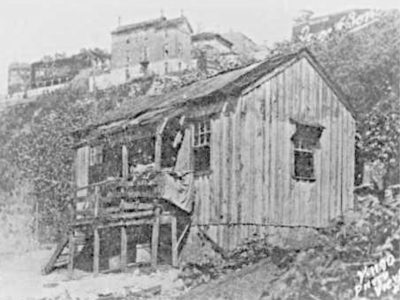Introduction:
This is installment three of the saga of Valentine Seeser, a resident of the shanty town located along the West Cliff area above the West Bottoms. Previously, the blog “Valentine Seeser’s House & The West Bottoms in Kansas City” introduced the community where Valentine lived. This blog describes the living conditions of those residing amongst the cliffs and how the city began to make an earnest effort at removing the shacks permanently.
Remarkably, people endured the harsh and unsanitary conditons of the bluffs and in Valentine’s case, this is where he and his wife raised their family.
Living on The West Bluffs of Kansas City
The description of Valentine’s house in 1893 was not an unusual case and reflected the conditions of many of the habitations along the bluff; dilapidated, eyesores, and unsanitary.
In 1890, the sanitation department completed a study of the West bluffs under the directions of the Assistant Sanitary Superintendent, Dr. Waring. Waring reported the area was “dotted” with “unsightly huts and three for a quarter cottages.” The superintendent warned the sanitary condition of the bluff was “hardly habitable.”

West Bluffs
Missouri Valley Special Collections, Kansas City Public Library, Kansas City, Mo.
The higher portion of the bluff where Valentine lived was bad enough, but the lower terraces were described as nothing more than a “seep hole for the higher portion of the city” and hardly “a fit place for anyone to live.”
In his report, which included results from chemical testing of water sources from “innumerable springs” along the bluff, Waring warned was polluted and unfit to drink. [1]
Living in such close proximity to the railroad yards, the belching smoke from industry, odors from stock pens, and the rattling of the street cars running up and down the bluff from early in the morning to late at night, could not have offered much comfort. Then, the potential of natural hazards made life precarious.
The Natural Hazards of the Bluffs
The bluff dwellers were also at risk from rock and mud slides tumbling down upon the shanties people called home.
In the spring of 1888, after heavy rains washed away soil from under the shelving rocks, huge boulders and tons of earth rolled down between Sixth and Ninth Streets. A large boulder “as large as an ordinary dwelling house” fell from a ledge above Lincoln Street smashing an engine house that lay below the 8th Street cable car tunnel. The slide occurred at night causing a deafening noise smashing two shanties that lay in the path. One two story dwelling near Lincoln and 7th Street was described as standing at an angle of 37 degrees after getting hit.
The next morning large sections of earth continued to fall through out the day and into the next. The bluff occupants were kept busy attempting to prop up their homes and additional slides were expected to occur as large sections of exposed shale and soapstone rocks were protruding over the edge threatening to fall down and crush the shanties below. [2]
In the spring of 1893, a large boulder weighing “twenty tons” smashed onto the shanty of Rachel Lightfoot after a storm had loosened it from the soil. The boulder destroyed the shanty she was living at 1010 Lincoln Street. Falling timbers fell down upon the sixty year old woman’s sleeping quarters trapping and killing her. [3]
This was the area where Valentine’s residence could be found as determined from directory records. Starting in 1886, Valentine can be found living between 8th and 9th street on Lincoln Street, starting. By 1890, his address is given as 815 Lincoln, the same address given in the 1893 newspaper article depicting his appearance in police court. [4]
The complaint against Valentine’s domicile coincides with major efforts of the city government to begin sanitizing the West Cliff area as part of a massive campaign of parks and avenues to make the city more attractive. The shanties where Valentine lived, had to go.
Next blog: The plans for Kansas City to beautify and rid the West Bluffs of the unsightly shanties for good. Valentine Seeser & Kansas City Urban Renewal
Genealogy Tip
Directories are rich resources and should always be a part of your searches. They have the potential to solve mysteries and brick walls.
In the Valentine case study, directories were instrumental in establishing his family’s whereabouts, occuaptions, and other valuable details to fill in gaps between more traditional record sets. Eventually, directory listings would be used to solve complicated riddles.
Endnotes:
1. “Its Sanitary Condition Bad,” Kansas City, Times, 11 Dec. 1890, pg. 8, col. 2.2.
2. “Tons of Earth Fall,” The Kansas City Star, 26 March 1888, pg. 1, col. 6.
3. “Crushed Like an Egg Shell,” Kansas City Times, 21 April 1893, pg. 8, col. 2.
4. Hoye’s, compiler, Hoye’s Kansas City Directory (Hoye City Directory Company, Kansas City), 1886, pg. 710, 1887, pg. 584, digital images, “U.S. City Directories, 1822 – 1995,” Ancestry.com ( accessed on 13 Apr. 2018). Hoye’s, compiler, Hoye’s Kansas City Directory (Hoye City Directory Company, Kansas City : 1890) 601, microfilm publication, “1890-1892 City Directory of Kansas City, Kansas & Missouri,” reel #4625, Johnson County Library, Main Resource Library, Overland Park, Kansas.
5. “The Bluff Park,” Kansas City Times, 27 July 1887, pg. 8, col. 1; “Its Sanitary Condition Bad” Kansas City, Times 11 Dec. 1890.